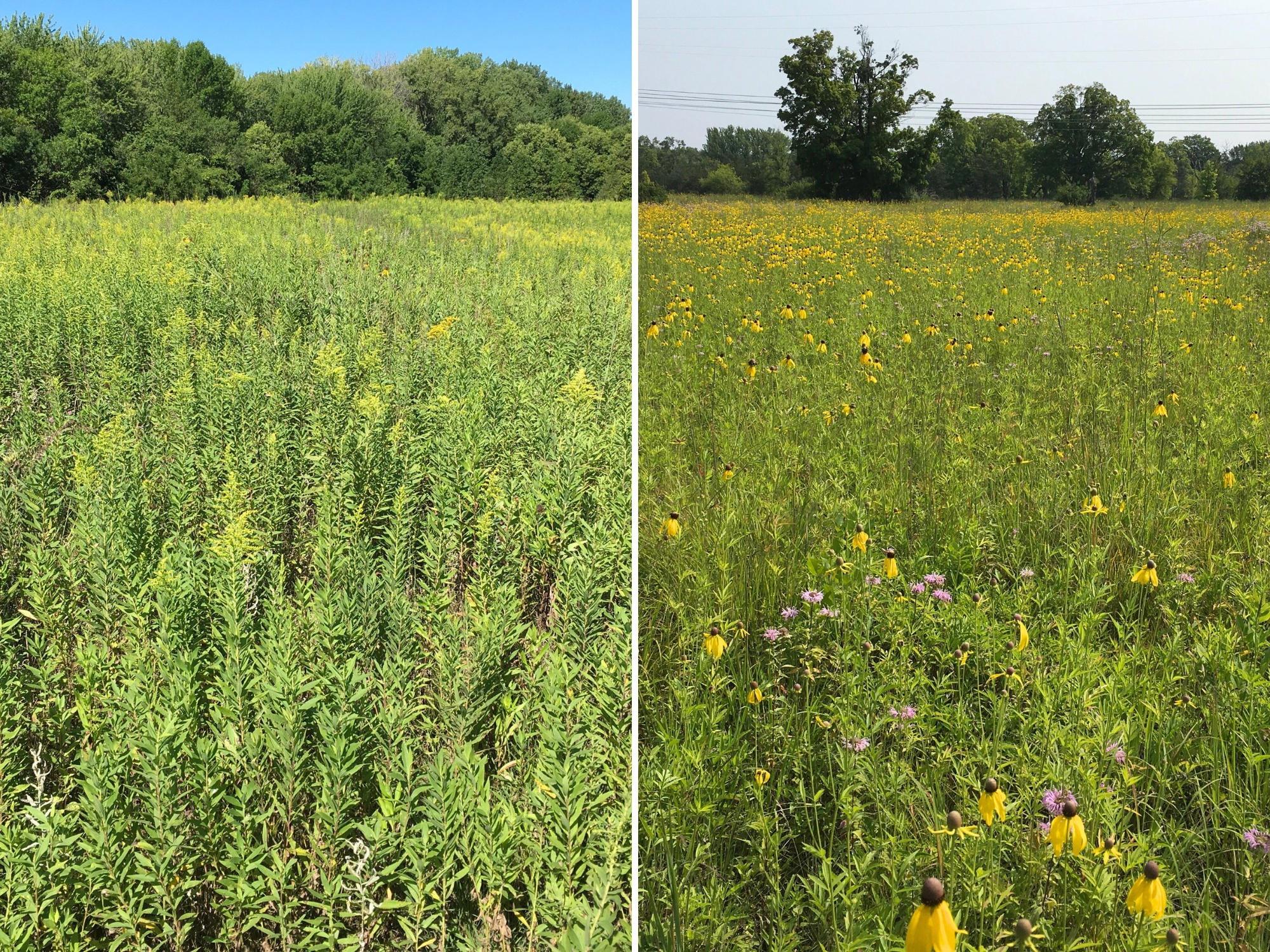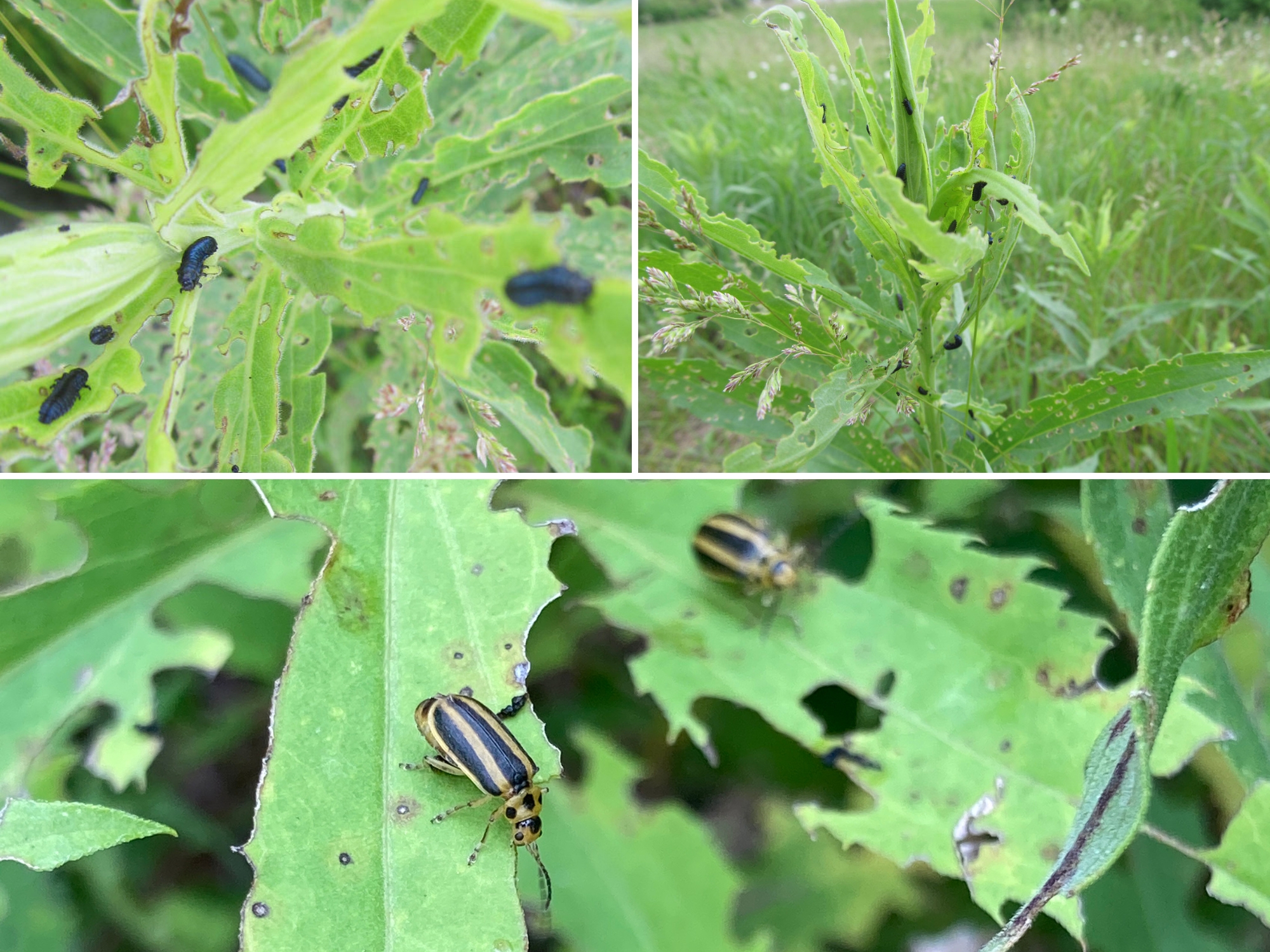How a little leaf beetle keeps Canada goldenrod in check

Left: Canada goldenrod had overtaken our prairie restoration at Gores WMA. Right: Over the course of a few years, leaf beetles were able to reduce the goldenrod, allowing gray-headed coneflower, bergamot and other native prairie plants to flourish again.
Sometimes too much of a good thing can be ... too much. That's the case when Canada goldenrod spreads rapidly at our prairie restoration project sites. But over time we've noticed something small making a big impact on plant diversity.
Canada goldenrod — native, but sometimes invasive
Canada goldenrod (Solidago canadensis) is native to Minnesota, and its bright yellow blooms spike up through prairies and savannas in late summer. It's a magnet for all kinds of pollinators and other insects. That's why goldenrod species are an important component of prairies and restorations.
However, it can spread very readily both by seed and by rhizomes — underground stem and root systems. In fact, in recent decades, Canada goldenrod seems to have become more and more invasive to the point where we've seen it overtake established prairies and crowd out most other plant species. You've probably seen what looks like fields of blooming goldenrod — and not much else — in late summer.
No matter how beneficial a plant is for wildlife, less diversity is rarely a good thing. Diverse plant communities provide habitat for the greatest variety of animals and are most resilient to disturbances. When there's an overabundance of one species, the whole system is out of balance.
It seemed strange to us that a native species was becoming so invasive. Plants have evolved together in ecosystems like these over thousands of years. Usually, nature has a way of keeping things in balance through predators, disease, fire and more. In an effort to maintain the diversity of our prairie restorations, we began introducing our own check: late-season mowing to reduce goldenrod at some sites.
Mowing has proven helpful to restore some balance to these sites. But it turned out that nature had its own control mechanism. We just had to be a little more patient.
Enter the leaf beetle

Leaf beetle larvae (top two photos) munch on goldenrod leaves, sometimes killing the whole plant. Adult leaf beetles (bottom photo) don't seem to be causing damage like the larvae do.
A few years ago we noticed a larval insect on Canada goldenrod at some of our sites that seemed to be voraciously eating the leaves of goldenrod plants.
The insect (Trirhabda canadensis) was a species of Chrysomelid beetle, or leaf beetle. The adults have two prominent yellow stripes on their backs, but it was the black larvae doing all the damage. We were glad to see something setting back the goldenrod, but the beetle larvae didn’t seem to be abundant enough to make a dent.
In 2023, however, these little beetles started to make a big impact.
At several sites where Canada goldenrod had become the dominant species — almost a monoculture — the plant was now almost gone or significantly reduced. Instead of a sea of goldenrod, we were seeing all the other native species that had been suppressed now suddenly growing again.
How nature balances itself
In high school biology class, you may have learned some basic tenets of nature's population dynamics: overly abundant prey animals are kept in check by an increase in predators (think snowshoe hare and lynx). That seems to be what's happening here. More Canada goldenrod means more food for the leaf beetle, which means more leaf beetles and — eventually — less goldenrod.
We wondered if the beetles would dine on the other native goldenrod species we want in the mix of our prairie and savanna restorations: showy, stiff, Missouri, gray, etc. (Did you know there are at least 18 species in Minnesota? Read more about goldenrod.) These species generally don't spread rapidly like Canada goldenrod, and they're all very important for pollinators. But so far, although the leaf beetles have been documented on other goldenrod species elsewhere, we've only observed the leaf beetles consuming Canada goldenrod.
While this success could point to harnessing these native beetles as a natural biocontrol, this observed relationship is too new to fully gauge its effectiveness, and we'd rather let nature act freely, in concert with our management efforts, to help us balance these systems.
As restoration ecologists, it's been neat to see nature balancing on its own. This is our hope for habitat restoration sites: that we're not only removing invasive plants and planting native ones, but that healthy interactions and relationships between different species return.